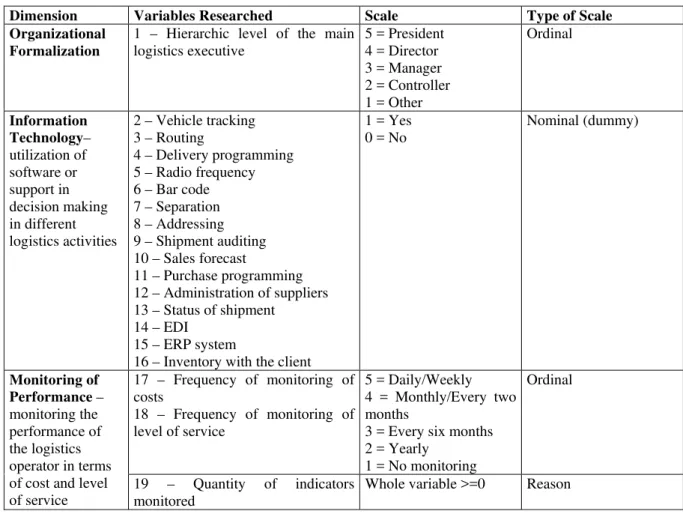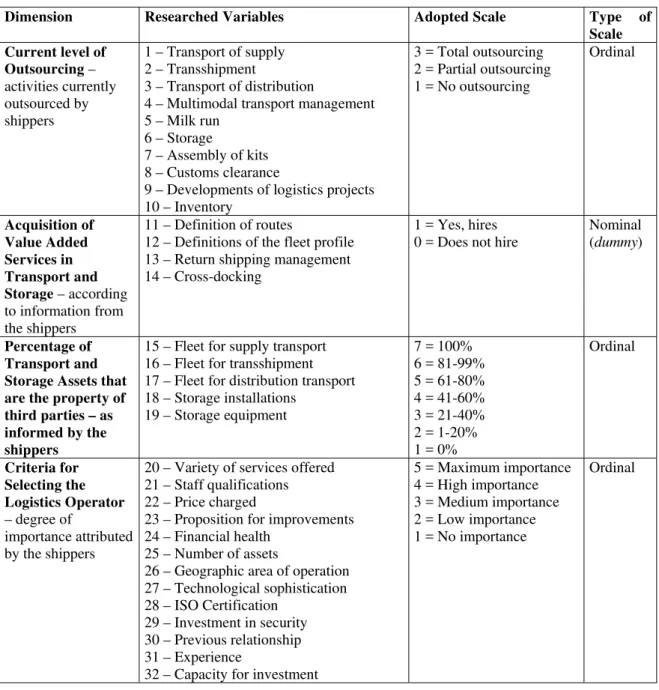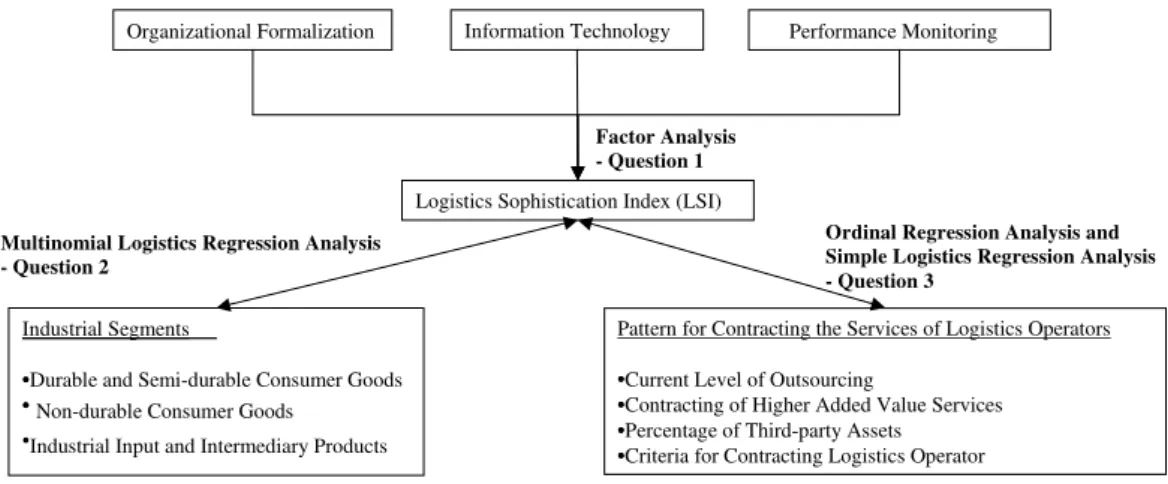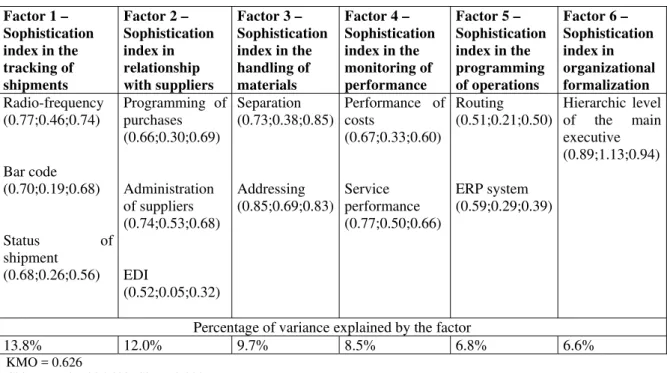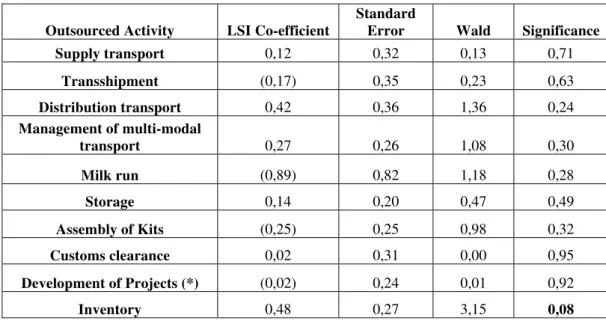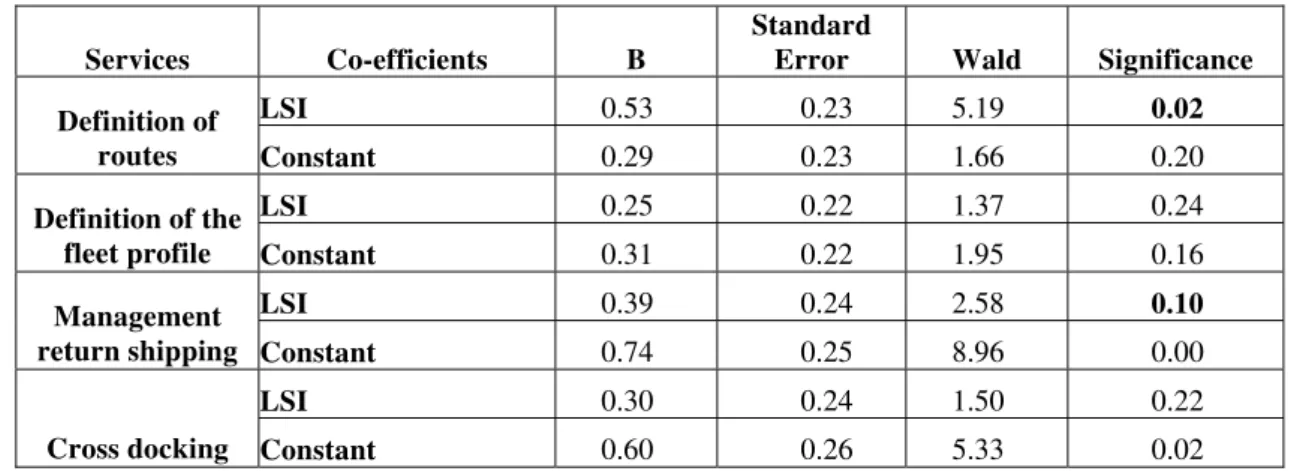BAR, v. 4, n. 3, art. 3, p. 31-46, Sept./Dec. 2007
A Study into the Impact of Logistics Sophistication of
Brazilian Shippers in the Pattern of Contracting the
Services of Logistics Operators
Peter Fernandes Wanke*
E-mail address: peter@coppead.ufrj.brInstituto COPPEAD, Universidade Federal do Rio de Janeiro Rio de Janeiro, RJ, Brazil
Paulo Fernando Fleury
E-mail address: fleury@coppead.ufrj.brInstituto COPPEAD, Universidade Federal do Rio de Janeiro Rio de Janeiro, RJ, Brazil
Maria Fernanda Hijjar
E-mail address: nanda@coppead.ufrj.br
Instituto COPPEAD, Universidade Federal do Rio de Janeiro Rio de Janeiro, RJ, Brazil
A
BSTRACTThe main objective of this study is to evaluate the impact of the logistics sophistication of Brazilian shippers on the acquisition pattern of 3PL (third-party logistics) service providers. The conceptual model of logistics sophistication and the major dimensions and variables relating to the acquisition pattern were defined and a questionnaire was sent to 218 Brazilian shippers listed on the Revista Exame ranking. Based on the 93 questionnaires returned, the analyses conducted indicate that the most sophisticated shippers are durable goods manufacturers and that they contract 3PL services providers for inventory management and higher value added services. In essence, these results indicate that the most sophisticated shippers seek 3PL service providers capable of managing logistics trade-offs such as inventory levels vs. asset utilization levels. These implications on the selection criteria of 3PL service providers are also discussed.
Key words: Brazilian shippers; 3PL acquisition; logistics sophistication.
Received 18 November 2004; received in revised form 14 March 2005.
Copyright © 2007 Brazilian Administration Review. All rights reserved, including rights for
translation. Parts of this work may be quoted without prior knowledge on the condition that
the source is identified.
*Corresponding author: Peter Fernandes Wanke
I
NTRODUCTIONTo achieve excellence in logistics operations, i.e., the capacity of a company to reduce costs and improve levels of service, has been the aim of a number of studies over the past fifteen years (Bowersox, Closs, & Stank, 1999, p. 2). These studies indicate high correlation between operational excellence and the degree of sophistication in the logistics organization. More specifically, these studies revealed that the sophistication of the linguistic organization of a company is reflected in a number of factors, such as: (1) emphasis on planning, monitoring of performance and ongoing investment in information technologies (Its); (2) commitment in establishing cooperative relationships with clients, suppliers and service providers; and (3) formalization and organizational integration of the various logistics activities.
It is seen that the factors that lead to operational excellence in logistics may be internal, such as organizational formalization, measurement of performance and the adoption of ITs; or it can be external, such as the development of cooperative relationships with other members of the chain. Specifically concerning external factors, the contracting of the services of 3PL operators has evolved rapidly in Brazil, and the rest of the world (Figueiredo, Fleury, & Wanke, 2003, p. 293). There are numerous possibilities for outsourcing logistics activities, ranging from the outsourcing of specific traditional activities, such as transport and storage, to the contracting of third parties to manage a wide range of activities in the supply chain.
These numerous possibilities increase the importance of the segmenting of services required by different types of shippers. For instance, it is possible that shippers with a higher degree of sophistication of logistics organization will tend to demand services of higher added value in comparison with less sophisticated shippers.
On the other hand, according to Fleury and Ribeiro (2001), the policy of segmenting services required by different types of industry is a clear tendency among logistics operators in the USA and Europe. The first criterion for the segmenting of services is generally the type of industry of the shipper, which allows for greater sector specialization and personalization. The authors point out that typical examples of priority industries for segmenting and the automobile, technology, foodstuffs and paper.
The main aim of this study is to help Brazilian logistics operators to define their strategic positioning concerning shippers in the industrial sector, firstly, through the understanding of the relationship between the services required by the shippers and their degree of logistics sophistication. As mentioned above, shippers with higher degrees of sophistication in logistics organization may request more sophisticated services of a higher added value. Understanding this relationship may create the basis for segmenting the services offered by logistics operators. For example, specific activities for less sophisticated shippers or integration projects on the supply chain for more sophisticated shippers.
Figure 1: Conceptual Flowchart of the Study
Logistics Excellence •Cost Reductions •Improved Level of Service
Degree of Sophistication of Logistics Organization
Internal Factors
• Organizational Formalization • Adoption of IT
• Monitoring of Performance
External Factors •
•Identify the Types of Sevice Required by More Sophisticated and Less Sophisticate Shippers
•Identify in Which Industries/ Sectors the More Sophisticated and Less Sophisticated Shippers are Concentrated
Aim of the Study
Strategic Positioning of Logistics Operators
Lower Added Value Services •Specific Activities
Higher Added Value Services •Integration of the Supply Chain
Tendency to Contract Third Parties
Development of the Logistics Operators Industry
•
•
• •
Development of Relationships Cooperative with Other Companies in the Chain
S
OPHISTICATION OFL
OGISTICSO
RGANIZATIONThe conceptual model of sophistication of logistics organization that is utilized in this study is the one presented by Lavalle and Fleury (2000), which constitutes an extension of the model developed by Bowersox and Daugherty (1992, p. 59). According to the model, the logistics sophistication can be broken down into three dimensions: degree of organizational formalization, use of information technology and indices of monitoring performance.
The degree of organizational formalization is the positioning of the main logistics executive in the organizational structure of the company. Traditionally, responsibility for logistics activities has always been fragmented and spread out (Van Amstel & Starrevel, 1993); and the hierarchic level of those in charge of these activities has always been low, implying a low degree of coordination. Greater logistics sophistication would partly be a reflex of the positioning of the executive in charge of logistics in higher levels of the organizational hierarchy, which would partly allow for the integrated management of different activities and the efficient choice of existing trade offs: inventory versus transport, inventory versus storage, transport versus storage, etc. (Lamber & Stock, 1998, p. 13).
Information technology concerns the wide range of uses of software and other support technologies for decision making in different logistics activities. According to Lavalle and Fleury (2000), “information technology makes viable the collection, analysis and transmission and of large quantities of accurate operational and managerial information in real time, allowing for a more streamlined decision making process”. When a decision making process is more streamlined, the operational cycles are shorter and adaptations are less traumatic.
analysis of performance indicators linked to costs and customer service results in greater knowledge of the activities as a whole which, in its turn, allows for greater flexibility of operations.
P
ATTERN FORC
ONTRACTING THES
ERVICES OFL
OGISTICSO
PERATORSIn this study, the pattern for contracting the services of 3PL operators is analyzed in four dimensions from the perspective of the shippers in the industrial sector: (1) current level of outsourcing of different logistics activities; (2) acquisition of higher added value services in transport and storage; (3) percentage of transport and storage assets which are the property of third parties; and (4) criteria for the selection of logistics operators.
According to Fleury and Ribeiro (2001), the contracting of the services of logistics operators has grown rapidly worldwide and, as a result, also in Brazil. The authors supply a number of proofs that at least one of the activities that make up logistics is done by a logistics operator in most companies in the United States and Europe. Sink and Langley (1996, 1997) point out that transport and storage, the activities that provided a beginning for most of the logistics operators in the USA, are still the services that are most requested and which most contribute to the turnover of the operators.
Fleury and Ribeiro (2001) also point out that, despite transport and storage, both in Brazil and the United States, being the activities which most contribute to the turnover of logistics operators, it is the services of higher added value of these activities that better differentiate logistics operators from providers of other specialized services such as transporters and storage companies. These higher added value services are normally related to the management of the supply chain of the flow of products and the resources that allow this flow to move through time and space. Examples of higher added value services are cross docking, the definition of collection and delivery routes, the definition of the profile of the fleet and the management of return shipping.
Finally, Wanke (1998, p. 53) introduces different criteria for the selection of logistics operators, compiled based on the review of previous literature. These criteria are divided into two large main groups: operational criteria, the focus of which are the activities that make up logistics; and managerial criteria, which include matters such as cultural and technical compatibility, training of staff and the competitive position of the logistics operator in the industry.
Examples of managerial criteria are the predisposition to the proposition of improvements, technological sophistication, investments in security, previous relationship, experience, capacity for investment and the financial health of the logistics operator. On the other hand, examples of operational criteria are ISSO Certification, the variety of services offered, the qualification of the staff, price charged, the number of assets and the geographical area of operation.
M
AINQ
UESTIONS ANDR
ESEARCHM
ETHODOLOGYBased on a review of the literature, three main research questions were formulated. The first concerns the construction of a sophistication index of the organization for Brazilian shippers from empirical data. The question may be formalized thus:
The next two questions concern the use of this organization logistics sophistication index for shippers from different sectors of the Brazilian economy and to assess the acquisition patterns for the services of logistics operators. These questions are:
2. Do shippers from different sectors of the Brazilian economy have statistically different indices of logistics sophistication? If so, what is the relationship that allows us to tell the difference between sectors of the Brazilian economy using the index of sophistication of logistics organization?
3. Do shippers with different indices of sophistication of logistics organization have different acquisition patterns for the services of logistics operators? If so, what is the relationship between the contracting of services of logistics operators and the index of sophistication of logistics organization of a shipper?
From the classification of the 500 largest in Exame Magazine, all the companies in the secondary/industrial sectors (340 in total) were selected. From March to July of 2003, 218 questionnaires were sent out to the logistics managers of these companies, of which 93 were answered and returned. The response rate was 43.7% of the questionnaires sent and 27.3% of those initially considered (companies from the secondary sector listed in the classification of Exame Magazine).
For the first part of the study, nineteen variables that were possibly related to the logistics sophistication of Brazilian shippers, from the industrial sector (i.e., related to organizational formalization, the use of information technology and performance measurement) were researched. These variables, their operalization and their scales are given in Table 1.
Table 1: Variables Related to the Logistics Sophistication of Shippers
Dimension Variables Researched Scale Type of Scale Organizational
Formalization
1 – Hierarchic level of the main logistics executive
5 = President 4 = Director 3 = Manager 2 = Controller 1 = Other
Ordinal Information Technology– utilization of software or support in decision making in different logistics activities
2 – Vehicle tracking 3 – Routing
4 – Delivery programming 5 – Radio frequency 6 – Bar code 7 – Separation 8 – Addressing 9 – Shipment auditing 10 – Sales forecast
11 – Purchase programming 12 – Administration of suppliers 13 – Status of shipment
14 – EDI 15 – ERP system
16 – Inventory with the client
1 = Yes 0 = No
Nominal (dummy)
17 – Frequency of monitoring of costs
18 – Frequency of monitoring of level of service
5 = Daily/Weekly 4 = Monthly/Every two months
3 = Every six months 2 = Yearly
1 = No monitoring
Ordinal
Monitoring of Performance – monitoring the performance of the logistics operator in terms of cost and level of service
19 – Quantity of indicators monitored
In order to construct the Logistics Sophistication Index (LSI) for Brazilian shippers in the industrial sector, the Factor Analysis technique was used in these nineteen variables. The Factor Analysis is recommended for cases in which there is a desire to calculate indices from the observed variables, using a theoretical construct as a basis. In this case, the theoretical construct is the sophistication of logistics organization.
Concerning the second research question, the 93 companies researched were grouped into three industrial segments of the economy: manufacturers of durable and semi-durable consumer goods; manufacturers of non-durable consumer goods; and manufacturers of industrial inputs and intermediary products. In Table 2, the clustering is summarized by the different sectors researched in the three main industrial segments.
Table 2: Groups of Sectors Researched in Three Main Industrial Segments (*)
Manufacturers of durable and semi-durable consumer goods
(29)
Manufacturers of non-durable consumer goods (25)
Manufacturers of industrial inputs and intermediary products (39)
Car (15) Foodstuffs (11) Chemical and Petrochemical (16) Electro-electronic (7) Beverages (6) Paper and cellulose (6)
Technology (4) Tobacco (1) Plastic and Rubber (1) Garments (3) Hygiene and Cleaning (4) Steel and Metal (11)
Communications (3) Building Material (5)
(*) The numbers in brackets show the number of companies that answered the questionnaire.
The discrimination of these three large industrial segments, with the Logistics Sophistication Index as an explicative variable (determined by Factor Analysis), was done through the Multinomial Logistics Regression Analysis. This technique is recommended for discriminating from amongst three or more groups due to a determined criterion owing to its flexibility. Its use and interpretation are very intuitive and analogous to the Multiple Linear Regression Analysis (Kleinbaum, Kupper, & Muller, 1998, p. 657) and there is no need to ensure the normality of the covariance of data matrices, just like Discriminant Analysis (Hair, Anderson, & Tatham, 1998, p. 244). The significance level considered was 0.10, acceptable according to Mentzer and Flint (1997), in exploratory research into logistics.
Table 3: Variables Pertaining to the Pattern of Contracting Logistics Operators
Dimension Researched Variables Adopted Scale Type of
Scale Current level of
Outsourcing – activities currently outsourced by shippers
1 – Transport of supply 2 – Transshipment
3 – Transport of distribution
4 – Multimodal transport management 5 – Milk run
6 – Storage
7 – Assembly of kits 8 – Customs clearance
9 – Developments of logistics projects 10 – Inventory
3 = Total outsourcing 2 = Partial outsourcing 1 = No outsourcing
Ordinal
Acquisition of Value Added Services in Transport and Storage – according to information from the shippers
11 – Definition of routes
12 – Definitions of the fleet profile 13 – Return shipping management 14 – Cross-docking
1 = Yes, hires 0 = Does not hire
Nominal (dummy)
Percentage of Transport and Storage Assets that are the property of third parties – as informed by the shippers
15 – Fleet for supply transport 16 – Fleet for transshipment 17 – Fleet for distribution transport 18 – Storage installations
19 – Storage equipment
7 = 100% 6 = 81-99% 5 = 61-80% 4 = 41-60% 3 = 21-40% 2 = 1-20% 1 = 0%
Ordinal
Criteria for Selecting the Logistics Operator
– degree of
importance attributed by the shippers
20 – Variety of services offered 21 – Staff qualifications 22 – Price charged
23 – Proposition for improvements 24 – Financial health
25 – Number of assets
26 – Geographic area of operation 27 – Technological sophistication 28 – ISO Certification
29 – Investment in security 30 – Previous relationship 31 – Experience
32 – Capacity for investment
5 = Maximum importance 4 = High importance 3 = Medium importance 2 = Low importance 1 = No importance
Ordinal
The choice of the statistical methods employed to relate the variables of different dimensions of the contracting pattern with the Logistics Sophistication Index involved observing the nature of their scales. Castro (1978, p. 93) points out the crucial importance of the compatibility between the scales of dependent variables and statistical tests.
Figure 2: Relationship between the Main Research Questions and the Adopted Methodology
Analysis of the Results
Organizational Formalization
Logistics Sophistication Index (LSI)
Industrial Segments
•Durable and Semi-durable Consumer Goods •
•Industrial Input and Intermediary Products
Pattern for Contracting the Services of Logistics Operators
•Current Level of Outsourcing
•Contracting of Higher Added Value Services •Percentage of Third-party Assets
•Criteria for Contracting Logistics Operator
Factor Analysis - Question 1
Ordinal Regression Analysis and Simple Logistics Regression Analysis - Question 3
Multinomial Logistics Regression Analysis - Question 2
• •
• • • •
Performance Monitoring Information Technology
Non-durable Consumer Goods
Concerning the first question, the extraction of main factors of the nineteen variables possibly related to the sophistication of logistics organization (see Table 1) was conducted by Factor Analysis with Normalized Varimax rotation for the sample with 93 observations. The results are given in Table 4 only for the load factors above 0.5 and eigenvalues greater than 1. According to Tabachnik and Fidell (2001, p. 645), only the load factors above 0.50 (25% of overposition in the variance) should be interpreted being able to affirm, in these cases, that the variable would be a good measurement of the factor. Thus, six main factors represent the degree of sophistication of logistics organization, interpreted as follows.
. The variables utilization of technologies of Radio frequency and bar codes and utilization of software for status of shipping information for the client make up Factor 1, interpreted as the
Index of Sophistication in the Tracking of Shipments (ISTS).
. The variables utilization of software for the programming of buying and management of suppliers and utilization of EDI technology make up Factor 2, interpreted as the Index of Sophistication in the Relationship with Suppliers (ISRS).
. The variables utilization of software for Separating and Addressing make up Factor 3, interpreted as the Index of Sophistication in the Handling of Materials (ISHM).
. The variables monitoring of costs and monitoring of level of service of the logistics operator make up Factor 4, interpreted as the Index of Sophistication of Monitoring of Performance (ISMP).
. The variables utilization of routing software and utilization of the ERP system make up Factor 5, interpreted as the Index of Sophistication in the Programming of Operations (ISPO).
. Finally, the variable hierarchic level of the main logistics executive in the company is confused with Factor 6, interpreted as the Index of Sophistication in Organizational Formalization (ISOF).
The Logistics Sophistication Index (LSI) employed to discriminate the three large industrial segments (manufacturers of durable consumer goods, manufacturers of non-durable consumer goods and manufacturers of industrial inputs and intermediary products) was calculated with a simple linear combination of these indices and varies from –4.1 to +4,1:
ISL = ISTS + ISRS + ISMM + ISMP + ISPO + ISOF
ISTS = 0.46[Radio frequency] + 0.19[Bar code] + 0.26[Status of shipment]
ISRS = 0.30[Programming of purchases] + 0.53[Management of suppliers] + 0.05[EDI]
ISHM = 0.38[Separation] + 0.69[Addressing]
ISMP = 0.33[Monitoring of costs] + 0.50[Monitoring of service]
ISPO = 0.21[Routing] + 0.29[ERP system]
ISOF = 1.13[Hierarchic level]
Table 4: Results of the Extraction of the Main Factors of Logistics Sophistication
Factor 1 – Sophistication index in the tracking of shipments
Factor 2 – Sophistication index in relationship with suppliers
Factor 3 – Sophistication index in the handling of materials
Factor 4 – Sophistication index in the monitoring of performance
Factor 5 – Sophistication index in the programming of operations
Factor 6 – Sophistication index in organizational formalization Radio-frequency (0.77;0.46;0.74) Bar code (0.70;0.19;0.68) Status of shipment (0.68;0.26;0.56) Programming of purchases (0.66;0.30;0.69) Administration of suppliers (0.74;0.53;0.68) EDI (0.52;0.05;0.32) Separation (0.73;0.38;0.85) Addressing (0.85;0.69;0.83) Performance of costs (0.67;0.33;0.60) Service performance (0.77;0.50;0.66) Routing (0.51;0.21;0.50) ERP system (0.59;0.29;0.39) Hierarchic level of the main executive
(0.89;1.13;0.94)
Percentage of variance explained by the factor
13.8% 12.0% 9.7% 8.5% 6.8% 6.6%
KMO = 0.626
Chi-squared = 305.409 (Sig. = 0.000)
The first value in brackets is the shipment factor
The second value in brackets is the co-efficient of the factor for standardized variables The third value in brackets is the communality of the variables
Concerning the second question, the discrimination of the three large industrial segments by the Logistics Sophistication Index was conducted the Multinomial Logistics Regression Analysis for the segment of manufacturers of industrial inputs and intermediary products as the benchmark (see Table 2). According to the co-efficients in Table 5, the Logistics Sophistication Index simultaneously discriminates the segments of manufacturers of durable/semi-durable and non-durable consumer goods from the benchmark at a level of significance of less than 0.10. According to Nagelkerke’s R squared, the sophistication of the logistics organization on its own accounts for 16.6% of the difference between the three industrial segments.
Table 5: Results of the Analysis of Multinomial Logistics Regression for the Industrial Segments Owing to the Logistics Sophistication Index (LSI)
Industrial Segment Co-efficients B
Standard
Error Wald Significance
Constant -0.57 0.27 4.23 0.04
Non-Durable Consumer
Goods LSI -0.44 0.27 2.80 0.09
Constant -0.47 0.27 2.98 0.08
Durable and Semi-Durable
Consumer Goods LSI 0.73 0.31 5.76 0.02
Cox and Snell R squared = 0.147 Nagelkerke R squared = 0.166
Chi-squared for the model = 14.823 (Sig = 0.001)
The co-efficient of the Logistics Sophistication Index for the segment of manufacturers of non-durable consumer goods is negative, indicating that, on average, manufacturers from this segment are less sophisticated than manufacturers of industrial inputs and intermediary products. On the other hand, the co-efficient of the LSI for the segment of manufacturers of durable/semi-durable consumer goods is positive, indicating that, on average, manufacturers from this segment are more sophisticated than manufacturers of industrial inputs and intermediary products. In Graph 1, the result of this system of multinomial equations is given, cognitively providing evidence for the interpretation of the:
. Logistics Sophistication Index under -2.83: shippers with a low level of logistics sophistication and predominant in (greater likelihood of belonging to) the segment of manufacturers of non-durable consumer goods.
. Logistics Sophistication Index between -2.83 and 1.59: shippers with a medium level of logistics sophistication and predominant in (greater likelihood of belonging to) the segment of manufacturers of industrial inputs.
. Logistics Sophistication Index above 1.59: shippers with a high level of logistics sophistication and predominant in (greater likelihood of belonging to) the segment of manufacturers of durable-semi-durable consumer goods.
Graph 1: Discrimination of Industrial Segments by the Logistics Sophistication Index
0,00% 10,00% 20,00% 30,00% 40,00% 50,00% 60,00% 70,00% 80,00% 90,00% 100,00%
-5 -4 -3 -2 -1 0 1 2 3 4
Logistics Sophistication Index
Non-durable
Durable / Semi-durable Industrial Input Low
Sophistication
High Sophistication
Pr
ob
ab
il
it
y
Concerning the third question, the relationship of the variables of the various dimensions dealing with the acquisition pattern for the services of logistics operators with the Logistics Sophistication Index was conducted by different methods owing to the different nature of the adopted scales (see Table 3)
Specifically pertaining to the variables of the current level of outsourcing dimension, an Ordinal Regression Analysis was conducted, with total outsourcing as the benchmark. Meanwhile, concerning the variables in the acquisition of higher added value services dimension, a Simple Logistics Regression Analysis was conducted, with does not hire as the benchmark. In turn, the
for selecting a logistics operator dimension, an Ordinal Regression Analysis, with maximum importance as the benchmark.
In the analyses conducted with the variables of the current level of outsourcing dimension, the LSI significantly discriminates, from the benchmark, the levels no outsourcing and partial outsourcing
only for inventory (p = 0.08). Its positive co-efficient is indicates that the higher the LSI of a shipper, the higher the level of outsourcing for inventory. The level of outsourcing of the other activities is not influenced by the LSI (see Table 6).
Table 6: Results of the Analyses of Ordinal Regression for the Variables Researched in the Current Level of Outsourcing Dimension
Outsourced Activity LSI Co-efficient
Standard
Error Wald Significance
Supply transport 0,12 0,32 0,13 0,71
Transshipment (0,17) 0,35 0,23 0,63
Distribution transport 0,42 0,36 1,36 0,24
Management of multi-modal
transport 0,27 0,26 1,08 0,30
Milk run (0,89) 0,82 1,18 0,28
Storage 0,14 0,20 0,47 0,49
Assembly of Kits (0,25) 0,25 0,98 0,32
Customs clearance 0,02 0,31 0,00 0,95
Development of Projects (*) (0,02) 0,24 0,01 0,92
Inventory 0,48 0,27 3,15 0,08
Benchmark: total outsourcing
The no outsourcing and partial outsourcing linear co-efficients have been omitted (*) No case found for the no oustourcing category
In the analyses conducted with the variables researched in the dimension of acquisition of the services of higher added value in transport and storage, the Logistics Sophistication Index significantly accounts for the definition of routes (p = 0.02) and the management of return shipping
Table 7: Results of the Analyses of Simple Logistics Regression for the Variables Researched in the Acquisition of Services of Higher Added Value Dimension
Services Co-efficients B
Standard
Error Wald Significance
LSI 0.53 0.23 5.19 0.02 Definition of
routes Constant 0.29 0.23 1.66 0.20
LSI 0.25 0.22 1.37 0.24
Definition of the
fleet profile Constant 0.31 0.22 1.95 0.16
LSI 0.39 0.24 2.58 0.10 Management
return shipping Constant 0.74 0.25 8.96 0.00
LSI 0.30 0.24 1.50 0.22
Cross docking Constant 0.60 0.26 5.33 0.02
Benchmark: does not contract
In the analysis performed with the variables researched in the percentage of transport and storage assets that belong to third parties dimension, the Logistics Sophistication Index significantly discriminates the levels of 0%, 1-20%, 21-40%, 41-60%, 61-80% and 81-99% for the variables of fleet for transport of supplies and fleet for transshipment (levels of significance of 0.10). Their positive co-efficients indicate that the higher the Logistics Sophistication Index of a shipper, the higher the percentage of the fleet for the transport of supplies and the fleet for transshipment that is the property of third parties. The LSI does not account for the percentage of assets that belong to third parties in the variables for fleet for distribution transport and storage installations and equipment (see Table 8).
Table 8: Results of the Ordinal Regression Analyses for the Variables Researched in the Percentage of Third-Party Assets for Transport and Storage Dimension
Outsourced Assets LSI Co-efficient Standard Error Wald Significance
Fleet for supply transport 0.43 0.27 2.60 0.10
Fleet for transshipment 0.46 0.25 3.29 0.07
Fleet for transport of distribution (*) 0.16 0.26 0.40 0.52
Installations for Storage 0.08 0.19 0.18 0.68
Storage Equipment (0.01) 0.19 0.00 0.97
Benchmark: 100%
The linear co-efficients for categories 0%, 1-20%, 21-40%, 41-60%, 61-80%, 81-99% have been omitted (*) No case found in 0% category
Finally, in the analyses carried out for the variables researched in the criteria for selection of the logistics operator dimension, the Logistics Sophistication Index significantly discriminates levels 1, 2, 3, and 4 for qualification of staff (p = 0.04) and propositions for improvements (p = 0.09),
Table 9: Results of the Analyses of Ordinal Regression for the Variables Researched in the Selection Criteria of Logistics Operator Dimension
Selection Criteria LSI Co-efficient
Standard
Error Wald Significance
Variety of services offered 0.23 0.19 1.50 0.22
Qualification of staff 0.43 0.21 4.24 0.04
Price charged (0.02) 0.22 0.01 0.94
Propositions for improvements 0.32 0.19 2.85 0.09
Financial health (*) 0.01 0.19 0.00 0.96
Quantity of assets (*) (0.05) 0.19 0.07 0.79
Geographical area of operation 0.14 0.19 0.56 0.46
Technological sophistication 0.72 0.20 12.66 0.00
ISO Certification 0.77 0.20 14.63 0.00
Investments in security 0.27 0.19 2.06 0.15
Previous relationship 0.03 0.19 0.03 0.87
Experience (0.14) 0.21 0.45 0.50
Capacity for investment 0.25 0.19 1.63 0.20
Benchmark: maximum importance.
The linear co-efficients for categories 1,2,3 and 4 have been omitted. (*) No case found category 1.
D
ISCUSSION OF THER
ESULTSThe results of the research show advances in the theoretical aspect and in the practical aspect of decision making. In the theoretical field, a logistics sophistication index was constructed that is capable of organizing shippers by their adoption of information technologies, organizational formalization and monitoring of performance. It was also possible, through this index, to observe that shippers with a higher degree of logistics sophistication are concentrated in the industrial segment of durable and semi-durable consumer goods, and that shippers with a lower level of logistics sophistication are concentrated in the non-durable consumer goods industrial segment.
In the practical aspect of decision making, the results of the study reflect the patterns of Brazilian shippers when it comes to outsourcing, concerning the logistics activities that are most passed on to third parties, services of higher aggregate value, the percentage of assets that is the property of third parties and the main criteria for selection. These patterns could be employed by logistics operators to help define their position in the market, i.e., to help them design specific logistics services for specific groups of shippers. These patterns could also be used to help define initiatives for training staff, concentrating on greater specialization by sector and personalized services. More specifically, the results of the study point out that more sophisticated Brazilian shippers tend to differ from the less sophisticated in the different dimensions that were researched in the acquisition pattern of the services of logistics operators.
trade offs for the costs of integrated logistics, which are linked to the ongoing choice between greater levels of stock and greater levels of utilization of resources (or assets), or lower levels of stock and lower levels of utilization of resources.
In this sense, shippers with a higher level of sophistication also stand out from the rest of the shippers in the contracting of other value added services in transport and storage. The definition of routes and the administration of return shipping are two new decisions that have come under the control of the logistics operator, who comes to have greater decision-making power over the utilization level of transport resources. Lower stock levels in transit (which depend directly on the sizes of the distribution lots) may, for instance, imply the need to increase the utilization of the capacity for vehicles through more aggressive management of return shipping. On the other hand, lower levels of cycle stock (which depend directly on the size of production and/or buying lot) may mean more frequent deliveries with evident impacts on the definition of routes.
More sophisticated shippers are also different when it comes to the percentage of third-party assets in transport. If, on the one hand, inventory management, definition of routes and management of return shipping mean an acquisition pattern that increases the decision-making power of the logistics operator when it comes to the inflows and outflows of input and products of the shipper, on the other hand, the ownership of the larger percentage of the supply and transshipping fleets is the reflection of this power of decision delegated to the operators.
Finally, in this scenario where logistics operators effectively administer the main integrated logistics trade offs of the shippers with a higher level of sophistication, selection criteria pertaining to staff qualifications, the proposition for improvements, technological sophistication and ISO Certification are highly relevant. In short, the more sophisticated shippers tend to contract logistics operators based on the skills of their human resources and the quality of their processes, elements that are, in a certain way, translated into the variables mentioned above. It is possible that in the near future the logistics operating industry in Brazil will undergo a wide-ranging process of improvements and staff training in addition to working towards greater technological sophistication. In the end, logistics operators will have to be prepared to administer the inflows and outflows of shippers from the point of view of a shipper, and not as a simple provider of services.
Figure 3: Summary of Results – Suggested Market Positioning for Brazilian Logistics Operators
Current level of Outsourcing
Acquisition of VA Services
% Assets of Third Parties
Selection Criteria
Sophistication of Logistics organization
Tracking of shipments
Relationship with suppliers
Handling of materials
Monitoring of performance
Programming of operations
Organizational formalization
Inventory or partial outsourcing
Definition of routs and management of return shipping
Increased percentage of outsourcing of fleets for transport or supplies and transshipment
Qualified staff, capable of making improvements; technological sophistication and ISO Certification
Manufacturers of Durable/Semi-durable consumer goods
Acquisition Pattern for the Services of Logistics Operators
C
ONCLUSIONSof outsourcing of their logistics activities and services of higher added value and the criteria for the selection of an operator.
Shippers from the durable/semi-durable consumer goods segment, tend to have higher indices of logistics sophistication, followed by shippers from the industrial input and intermediary products segment and shippers from the non-durable consumer goods segment. Shippers with higher indices of logistics sophistication have a greater tendency to hire logistics operators that are capable of managing the main trade off of integrated logistics: the commitment between inventories and the levels of utilization of resources. This decision clearly affects the criteria for their selection: the change from the focus of price versus service to the training of human resources and the streamlined business processes of the logistics operator.
Future analyses should be done of the sample collected to complement the conceptual chart given here. The aim of these analyses would be to identify other variables outside of the index of logistical sophistication, which differentiate between the acquisition pattern for logistics operators in companies of the industrial sector. Variables such as turnover and structure of the productive process could be considered.
R
EFERENCESBowersox, D. J., Closs, D. J., & Stank, T. P. (1999). 21st century logistics: making supply chain integration a reality. Oak Brooks: Council of Logistics Management.
Bowersox, D. J., & Daugherty, P. J. (1992). Logistical excellence: it’s not business as usual. New York: Digital Press.
Castro, C. M. (1978). A prática da pesquisa. São Paulo: McGraw-Hill.
Figueiredo, K. F., Fleury, P. F., & Wanke, P. (2003). Logística e gerenciamento da cadeia de suprimentos: planejamento do fluxo de produtos e dos recursos. São Paulo: Atlas.
Fleury, P. F., & Ribeiro, A. (2001). A indústria de prestadores de serviços logísticos no Brasil: caracterizando os principais operadores. Anais do Encontro Nacional dos Programas de Pós-Graduação em Administração, Campinas, SP, Brasil, 25.
Hair, J. F., Anderson, R. E., & Tatham, R. L. (1998). Multivariate data analysis (5th ed.). New York: Prentice Hall.
Kleinbaum, D., Kupper, L., & Muller, K. (1998). Applied regression analysis and other multivariable methods (2a ed.). New York: Duxbury Press.
Lambert, D. M., & Stock, J. R. (1998). Fundamentals of logistics management. New York: Irwin-McGraw Hill.
Lavalle, C., & Fleury, P. F. (2000). Avaliação da organização logística em empresas da cadeia de suprimentos de alimentos. Revista de Administração Contemporânea, 4(1), 47-67.
Mentzer, J. T., & Flint, D. J. (1997). Validity in logistics research. Journal of Business Logistics, 18(1), 199-216.
Sink, H. L., & Langley, J. C. (1996). Buyer observations of the US third-party logistics market. International Journal of Physical Distribution & Logistics Management, 26(3), 38-46.
Tabachnick, B. G., & Fidell, L. S. (2001). Using multivariate statistics. Boston: Allyn and Bacon.
Van Amstel, W. P., & Starreveld, D. W. (1993). Does your company need a logistical executive? The International Journal of Logistics Management, 4(1), 48-58.

